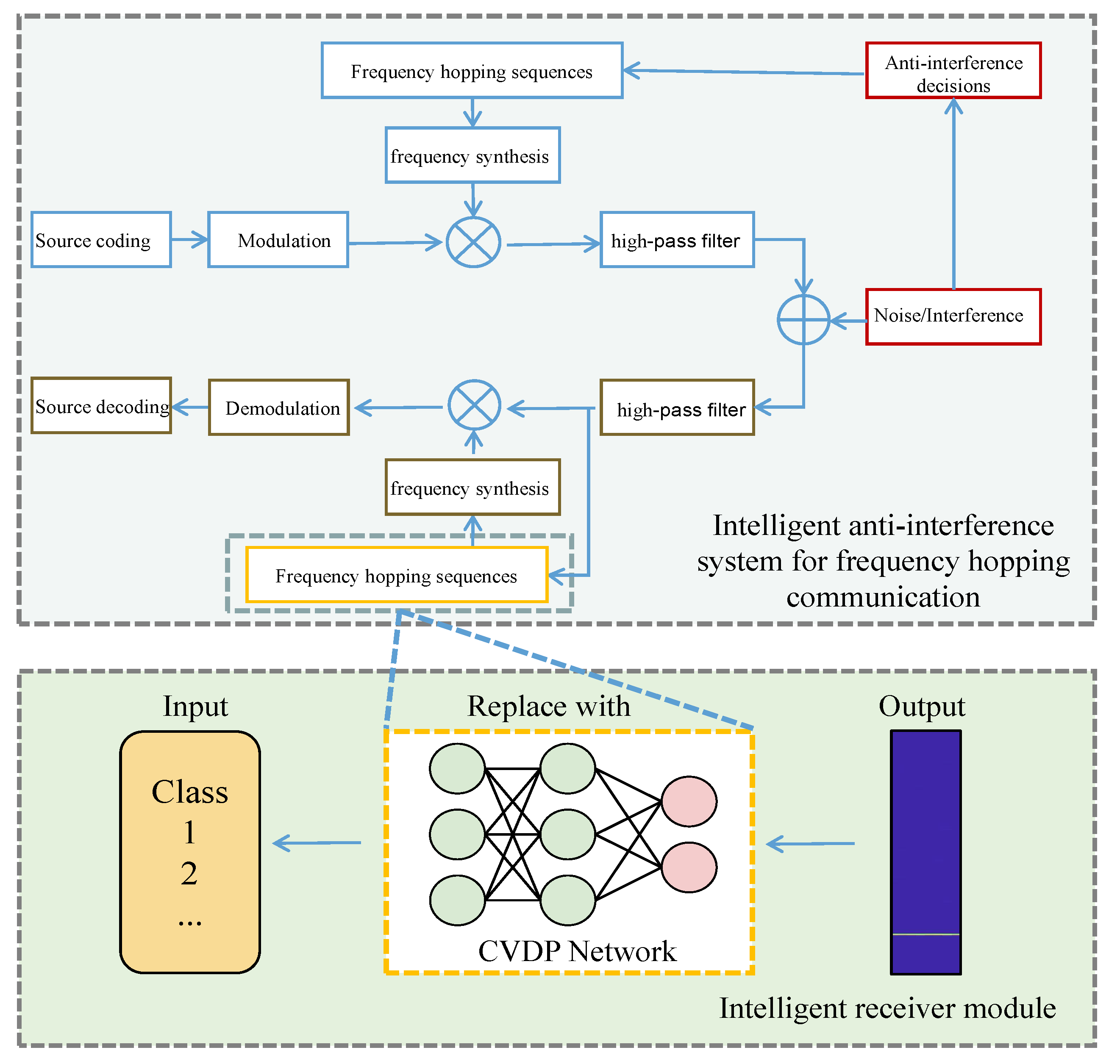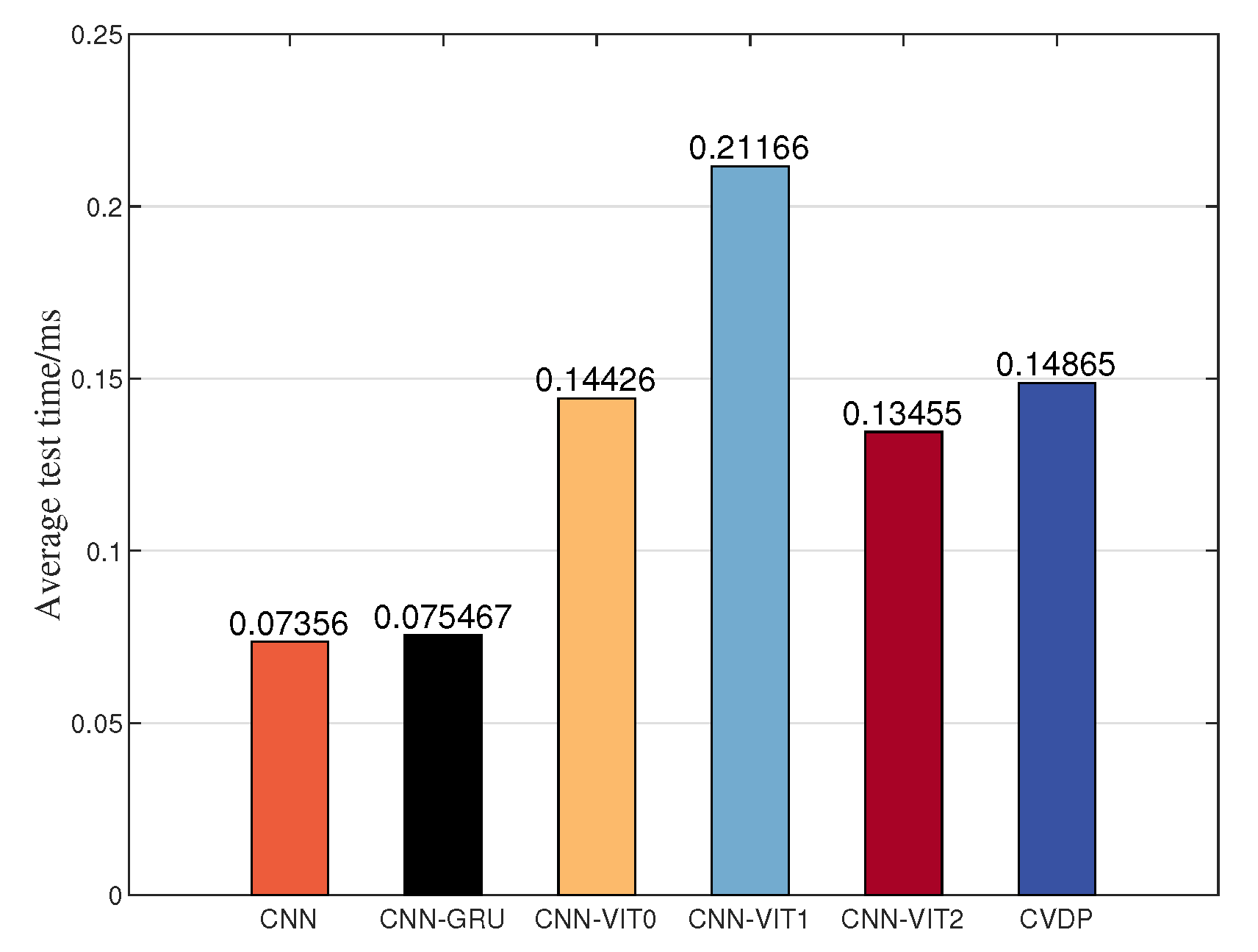Intelligent Reception of Frequency Hopping Signals Based on CVDP
Abstract
:1. Introduction
- We design a CVDP network that exhibits robust generalization performance for the estimation of hopping frequency during the one-time slot. This network reduces the delay and overcomes the difficulty of training due to few features and a small data set of frequency hopping signals in the one-time slot.
- The CVDP network combines the inductive bias property of CNN networks with the global inductive modeling capability of VIT networks [28] to solve the problem of poor convergence of VIT networks on small data sets and to improve the stability and robustness of VIT networks. A dual multi-head self-attention mechanism is proposed for extracting the time-frequency features of different low-dimensional subspaces to improve the network performance. Meanwhile, the idea of self-attention [29] is introduced to calculate only the self-attention of key points to reduce the computational complexity.
- Extensive simulation experiments have been conducted to evaluate the performance of the CVDP network in various scenarios, including multi-tone interference, single-band interference, multi-band interference, swept frequency interference, mixed interference, and channel fading, encompassing both frequency-flat Rayleigh fading and frequency-selective Rayleigh fading. The simulation results indicate that the CVDP network exhibits a high level of generalization performance across all of these environments. Moreover, the intelligent receiver system, which incorporates the CVDP network, performs remarkably close to an ideal receiver when dealing with an unknown frequency hopping sequence.
2. CVDP Network Design
2.1. Signal Models
2.2. Network Structure
2.2.1. CNN Module
2.2.2. Transformer Encoder Module
2.3. Loss Function
3. Algorithm Simulation and Performance Analysis
3.1. Data Set Generation and Hyperparameter Setting
3.2. Estimation Performance of Hopping Frequency
3.2.1. Experiment 1
3.2.2. Experiment 2
3.3. Performance of Frequency Hopping Intelligent Reception
4. Conclusions
Author Contributions
Funding
Institutional Review Board Statement
Informed Consent Statement
Data Availability Statement
Conflicts of Interest
References
- Li, C.; Qi, P.; Wang, D. On the anti-interference tolerance of cognitive frequency hopping communication systems. IEEE Trans. Reliab. 2020, 69, 1453–1464. [Google Scholar] [CrossRef]
- Zhu, J.; Zhao, Z.; Zheng, S. Intelligent anti-jamming decision algorithm of bivariate frequency hopping pattern based on DQN with PER and Pareto. Int. J. Inf. Technol. Web Eng. 2022, 17, 1–23. [Google Scholar] [CrossRef]
- He, H.; Wen, C.K.; Jin, S. Deep learning-based channel estimation for beamspacemmWave massive MIMO systems. IEEE Wirel. Commun. Lett. 2018, 7, 852–855. [Google Scholar] [CrossRef] [Green Version]
- Yang, Y.; Gao, F.; Ma, X. Deep learning-based channel estimation for doubly selective fading channels. IEEE Access 2019, 7, 36579–36589. [Google Scholar] [CrossRef]
- Bai, Q.; Wang, J.; Zhang, Y. Deep learning-based channel estimation algorithm over time selective fading channels. IEEE Trans. Cogn. Commun. Netw. 2019, 6, 125–134. [Google Scholar] [CrossRef] [Green Version]
- Mao, H.; Lu, H.; Lu, Y. RoemNet: Robust Meta Learning Based Channel Estimation in OFDM Systems. In Proceedings of the ICC 2019—2019 IEEE International Conference on Communications (ICC), Shanghai, China, 20–24 May 2019. [Google Scholar]
- Soltani, M.; Pourahmadi, V.; Mirzaei, A. Deep learning-based channel estimation. IEEE Commun. Lett. 2019, 23, 652–655. [Google Scholar] [CrossRef] [Green Version]
- Li, L.; Chen, H.; Chang, H.H. Deep residual learning meets OFDM channel estimation. IEEE Wirel. Commun. Lett. 2019, 9, 615–618. [Google Scholar] [CrossRef]
- Zhang, L.; Yang, L.L. Machine learning for joint channel equalization and signals detection. Mach. Learn. Future Wirel. Commun. 2020, 213–241. [Google Scholar] [CrossRef]
- Ouyang, X.; Wu, L. Faster-than-Nyquist rate communication via convolutional neural networks-based demodulators. J. Southeast Univ. 2016, 32, 6–10. [Google Scholar]
- Fang, L.; Wu, L. Deep Learning Detection Method for Signals Demodulation in Short Range Multipath Channel. In Proceedings of the 2017 IEEE 2nd International Conference on Opto-Electronic Information Processing (ICOIP), Singapore, 7–9 July 2017; pp. 16–20. [Google Scholar]
- Zhang, L.; Zhang, H.; Jiang, Y. Intelligent and reliable deep learning LSTM neural networks-based OFDM-DCSK demodulation design. IEEE Trans. Veh. Technol. 2020, 69, 16163–16167. [Google Scholar] [CrossRef]
- Zhang, X.; Luo, T. A RNN Decoder for Channel Decoding under Correlated Noise. In Proceedings of the 2019 IEEE/CIC International Conference on Communications Workshops in China (ICCC Workshops), Changchun, China, 11–13 August 2019; pp. 30–35. [Google Scholar]
- Yang, X.; Zhang, L.; Wu, Z. A unified convolutional neural network classifier aided intelligent channel decoder for coexistent heterogeneous networks. IEEE Syst. J. 2021, 15, 5630–5633. [Google Scholar] [CrossRef]
- Ye, H.; Li, G.Y. Initial Results on Deep Learning for Joint Channel Equalization and Decoding. In Proceedings of the 2017 IEEE 86th Vehicular Technology Conference (VTC-Fall), Toronto, ON, Canada, 24–27 September 2017; pp. 1–5. [Google Scholar]
- Ye, H.; Li, G.Y.; Juang, B.H. Power of deep learning for channel estimation and signals detection in OFDM systems. IEEE Wirel. Commun. Lett. 2017, 7, 114–117. [Google Scholar] [CrossRef]
- O’Shea, T.; Hoydis, J. An introduction to deep learning for the physical layer. IEEE Trans. Cogn. Commun. Netw. 2017, 3, 563–575. [Google Scholar] [CrossRef] [Green Version]
- Dörner, S.; Cammerer, S.; Hoydis, J. Deep learning based communication over the air. IEEE J. Sel. Top. Signals Process. 2017, 12, 132–143. [Google Scholar] [CrossRef] [Green Version]
- Ye, H.; Liang, L.; Li, G.Y. Deep learning-based end-to-end wireless communication systems with conditional GANs as unknown channels. IEEE Trans. Wirel. Commun. 2020, 19, 3133–3143. [Google Scholar] [CrossRef] [Green Version]
- Zheng, S.; Chen, S.; Yang, X. DeepReceiver: A deep learning-based intelligent receiver for wireless communications in the physical layer. IEEE Trans. Cogn. Commun. Netw. 2020, 7, 5–20. [Google Scholar] [CrossRef]
- Hou, F.; Yao, Z.; Yang, J. A fast detection method of frequency hopping signal based on K-means clustering. Telecommun. Eng 2022, 62, 199–205. [Google Scholar]
- Lee, K.G.; Oh, S.J. Detection of frequency-hopping signals with deep learning. IEEE Commun. Lett. 2020, 24, 1042–1046. [Google Scholar] [CrossRef]
- Li, C.; Zhao, Z.; Chen, Y. Detection algorithm of frequency hopping signals based on S Transform and Deep Learning. IEEE Int. Conf. Signal Process. 2022, 1, 310–313. [Google Scholar]
- Lei, Z.; Zheng, L.; Ding, H. Prediction and Separation of Synchronous-Networking Frequency Hopping Signals Based on rbf Neural Network. In Proceedings of the 2016 8th International Congress on Ultra Modern Telecommunications and Control Systems and Workshops (ICUMT), Lisbon, Portugal, 18–20 October 2016; pp. 427–431. [Google Scholar]
- Li, G.; Xu, J.; Shen, W. LSTM-Based Frequency Hopping Sequence Prediction. In Proceedings of the 2020 International Conference on Wireless Communications and Signal Processing (WCSP), Nanjing, China, 21–23 October 2020; pp. 472–477. [Google Scholar]
- Li, G.; Wang, W.; Ding, G. Frequency-hopping frequency reconnaissance and prediction for non-cooperative communication network. China Commun. 2021, 18, 51–64. [Google Scholar] [CrossRef]
- Zhu, J.; Wang, A.; Wu, W. Deep-Learning-Based Recovery of Frequency-Hopping Sequences for Anti-Jamming Applications. Electronics 2023, 12, 496. [Google Scholar] [CrossRef]
- Dosovitskiy, A.; Beyer, L.; Kolesnikov, A. An image is worth 16 × 16 words: Transformers for image recognition at scale. arXiv 2020, arXiv:2010.11929. [Google Scholar]
- Zhou, H.; Zhang, S.; Peng, J. Informer: Beyond Efficient Transformer for Long Sequence Time-Series Forecasting. In Proceedings of the AAAI Conference on Artificial Intelligence, Online, 2–9 February 2021; pp. 11106–11115. [Google Scholar]
- Bello, I.; Zoph, B.; Vaswani, A. Attention Augmented Convolutional Networks. In Proceedings of the IEEE/CVF International Conference on Computer Vision, Seoul, Republic of Korea, 27 October–2 November 2019; pp. 3286–3295. [Google Scholar]









| Index | Layers | Structure | Structural Parameters (Kernel Size, Stride) | Output Dimension |
|---|---|---|---|---|
| 1 | Input | - | - | 3 × 256 × 128 |
| 2 | Conv1 | Conv-BN-ReLU | 7 × 7 × 64.2 | 64 × 128 × 64 |
| 3 | M | Maxpool | 3 × 3 × 64.2 | 64 × 64 × 32 |
| 4 | Res1 | Conv-BN-ReLU Conv-BN-ReLU | 3 × 3 × 64.0 3 × 3 × 64.2 | 64 × 64 × 32 |
| 5 | Res2 | Conv-BN-ReLU Conv-BN-ReLU | 3 × 3 × 128.0 3 × 3 × 128.2 | 128 × 32 × 16 |
| 6 | Res3 | Conv-BN-ReLU Conv-BN-ReLU | 3 × 3 × 256.0 3 × 3 × 256.2 | 256 × 16 × 8 |
| Experimental Environment | Environment Configuration |
|---|---|
| Operating System | Win 10 |
| CPU | Intel Core i5-12400F |
| GPU | NVIDIA RTX3060 |
| Memory | 16 GB |
| Programming Languages | Python 3.9 |
| Deep Learning Framework | PyTorch 1.12 |
Disclaimer/Publisher’s Note: The statements, opinions and data contained in all publications are solely those of the individual author(s) and contributor(s) and not of MDPI and/or the editor(s). MDPI and/or the editor(s) disclaim responsibility for any injury to people or property resulting from any ideas, methods, instructions or products referred to in the content. |
© 2023 by the authors. Licensee MDPI, Basel, Switzerland. This article is an open access article distributed under the terms and conditions of the Creative Commons Attribution (CC BY) license (https://creativecommons.org/licenses/by/4.0/).
Share and Cite
Yuan, Z.; Zhao, Z.; Zhang, Y.; Zheng, S.; Dai, S. Intelligent Reception of Frequency Hopping Signals Based on CVDP. Appl. Sci. 2023, 13, 7604. https://doi.org/10.3390/app13137604
Yuan Z, Zhao Z, Zhang Y, Zheng S, Dai S. Intelligent Reception of Frequency Hopping Signals Based on CVDP. Applied Sciences. 2023; 13(13):7604. https://doi.org/10.3390/app13137604
Chicago/Turabian StyleYuan, Ze, Zhijin Zhao, Yupei Zhang, Shilian Zheng, and Shaogang Dai. 2023. "Intelligent Reception of Frequency Hopping Signals Based on CVDP" Applied Sciences 13, no. 13: 7604. https://doi.org/10.3390/app13137604
APA StyleYuan, Z., Zhao, Z., Zhang, Y., Zheng, S., & Dai, S. (2023). Intelligent Reception of Frequency Hopping Signals Based on CVDP. Applied Sciences, 13(13), 7604. https://doi.org/10.3390/app13137604





